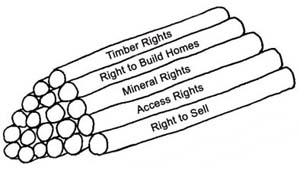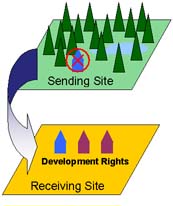Glossary of TDR Terms
Development right
Land ownership is commonly described as consisting of a bundle of different rights. Usually when someone purchases land, they purchase the entire bundle of rights associated with the land.
Some of the more common rights include ownership of any mineral deposits under the land, or the timber growing on the land. Owning a development right means that you own the right to build a structure on the parcel. Development rights may be voluntarily separated and transferred from the land. The number of development rights a parcel has depends on zoning, acreage, and existing development. The number of rights available for transfer may differ (see King County TDR Code and sending site information.)

Illustration of a bundle of Development Rights
Sending site

Illustration of development rights transferring from sending site to receiving site
The sending site is the parcel of land from which development rights will be transferred. After transferring the development rights from the sending parcel, future development is limited according to the terms of the conservation easement which is placed over the sending site at the time of transfer. King County Code outlines the specific eligibility criteria for sending sites, but generally sending sites are rural parcels providing productive agricultural or forestry values, critical wildlife habitat or other public benefits such as open space, regional trail connectors. Urban parcels can send development rights if they are urban separators zoned R-1 or land purchased as urban open space using Conservation Futures Tax funding.
Receiving site
Receiving sites are sites to which development rights are transferred. Typically, these are parcels of land in urban areas where the existing services and infrastructure can accommodate additional growth. Development rights that are "sent" off of a sending site are placed on a receiving site. Landowners may place development rights onto a receiving site either by transferring them from a qualifying parcel they own, or by purchasing the development rights from a sending site landowner with certified TDRs, or purchasing them from the King County TDR Bank. Receiving site landowners may develop the receiving site at a higher density than is otherwise allowed by the base zoning. For more information about receiving sites, see receiving site information and King County Code.
Qualified sending site
A property may be qualified as a sending site by successful completion of the TDR application process, but prior to signing and placement of a conservation easement. The TDRs do not become a tradable commodity until a conservation easement has been recorded and the TDRs have been concurrently “certified.”
Certified TDRs
After going through the enrollment process, the final step is to "certify" the TDRs at which point the TDRs become tradable commodity. At the same time TDRs are certified, a conservation easement is placed over the sending site.
Rural TDR
A transferable development right removed from a sending site within one of the following rural zones: RA-2.5, RA-5, RA-10, RA-20, A, or F.
Urban TDR
A transferable development right removed from a sending site in the R-1, R-4, R-6, R-8, R-12, R-18, R-24, or R-48* zone.
(*NOTE: Properties in R-4, R-6, R-8, R-12, R-18, R-24, and R-48 are eligible only if they are also designated as urban residential medium or high in the King County Comprehensive Plan, and are approved for Conservation Futures Tax funding by the King County Council.)
Conservation easement
Conservation easements come in many different forms and the specific conditions may vary depending on the purpose of the easement. Generally speaking, a conservation easement is a record on the property title that permanently restricts some or all future development. Frequently landowners will retain one development right in order to build a single-family residence on the land. While land covered by a conservation easement restricts certain types of land-use, the land itself remains in private ownership. Depending on the criteria used to qualify a sending site, a range of uses may be permitted under the conservation easement, such as agricultural, forestry, or recreational uses. To ensure compliance with the terms of a conservation easement, all easements have a provision allowing King County staff to access the property after giving advance notice to the landowner.
Density
Density is the number of dwelling units (DUs) per acre. Existing density is calculated based on acreage and existing development. Potential density - based on acreage and zoning - predicts the number of dwelling units that could be placed on a given parcel.
TDR banking
If someone purchases development rights from a sending site but doesn't use them right away on a receiving site, the person is said to be "banking" the development rights. The sending site property owner might also bank development rights by separating the rights from the parcel and placing a conservation easement on the land. The property owner would then have a certificate for the number of development rights allowed that could be sold or used on a receiving site. Under some circumstances, the King County TDR Bank purchases development rights and holds the TDRs for later sale owners of qualified receiving sites.
Extinguishing development rights
When someone uses a development right to build a dwelling unit on a qualified receiving site, the development right is "extinguished." After extinguishment, the TDR cannot be used again in any other location for any purpose.

 Translate
Translate